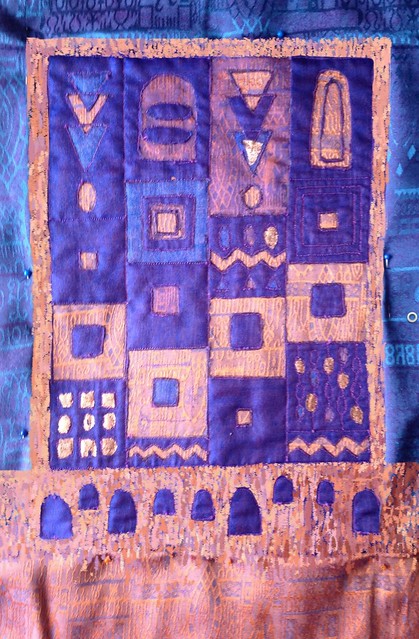We had the pleasure of
Alice Fox teaching at Studio 11 last weekend at one of the studio's "
Re-Treats". It was the hottest weekend of the year, but that didn't stop us from enjoying ourselves.
We were 8 students plus Alice, and Christine was there to greet us, and to provide us with a lovely lunch each day. The participants ranged widely in experience and practice from my still very novice, to artists who exhibit nationally and internationally. We were asked to talk about ourselves and what "our thing" was to start with. It was really interesting to hear different people's paths to textiles, though I had to confess that I was still trying to find my "thing". Alice talked to us about the way she looks on using found materials as deeply bound up with her desire to tread lightly on the earth and work with the places and things that life brings her.
We spent some time on each of the first three days wandering by the seaside picking up items that could be used for rust printing, eco printing or monoprinting, hence the title of the workshop "Printing the Coast". The first day was spent on
Eastbourne beach, on day two it was off to
Cuckmere Haven, and day three was foraging at
Birling Gap - where I inadvertently discovered the nudist part of the beach. I felt very overdressed! The weather each day was wonderful, the sky pure blue and the sea gentle on the shoreline.
Each trip involved collecting; collecting objects, impressions, marks, feelings, sensations. Alice encouraged us to
just sit and be with the place we were exploring, and it was such a delight to do this; to walk and absorb the locality, looking closely, asking ourselves how this place feels, and collecting things to work with later. We took
little folded books, which Alice showed us how to make, and used these to record thoughts and impressions; using local materials to colour the paper, making quick sketches, noting down marks on the landscape.
These, along with the things we collected, and other papers and fabrics we had brought, were what we worked with back in the studio. A period of each day was spent with a different process, and with preparing materials for the following day's foraging.
On the first day we explored rust dyeing. Alice noted that although lots of instructions online suggest using vinegar for this, you can also use tea of all sorts - the tannic acid being a more sympathetic catalyst on the collected metals. Vinegar tends to just give you tones of orange, whereas tea will bring all sorts of other greys and deep tones to the mix.
An important element is serendipity - different fabrics will take the marks differently - here a slik noil above, and a dupion silk below show quite a variation in the type and colour in the impression from rusty nails and "stuff"
On the second day we were taught eco printing, using the plant materials we had collected, bundled with fabrics, pressed between the leaves of our books, and placed in the steamer to do its magic. I experimented a bit more this at home. The colours here slightly more subtle than in real life, on a fine weave silk cotton mix whihc really shows the detail from maple and hawthorn
and silk noil again with ash leaves from the Cuckmere walk over rust prints from the beach
The third day was spent monoprinting with the objects we had collected. Mine were mostly made using plant materials and feathers. Other used the printing press in the studio to create collagraphs.
On day four we brought all these things together, using our fabrics, booklets and printed materials to create slightly bigger books. In my case one of them turned into a bit of a monster, albeit a small monster, since each signature is only 7.5x10 cm, but there are twelve of them bound together.
You can see pictures of all our work
here, though you may have to scroll down a bit if it's been a while since the course.
As with all previous courses I've been on, along with the teaching, one of the great pleasures is meeting others, seeing what inspires them and enjoying the company of like minded souls. One of the things we commented on during one lunch break was the prevalence of women on this sort of course. Alice said she'd only had a couple of male participants on her previous courses. Something to ponder I think - are we women more willing to integrate creativity into our "ordinary" lives, rather than needing the kudos of being part of a bigger commercial artistic (or sporting) movement? Do we enjoy the participatory and non competitive nature of this sort of artistic expression, or are we simply a self-selected group whose minds and lives move with and are moved by this sort of making? I think a long conversation could ensue - perhaps I'll suggest it to Christine for one of our studio discussions.
So, a wonderful four days, some great fun, many new ideas to absorb and work with, all mediated by Alice's generous teaching and willingness to share. If you want to know more, I recommend her book
Natural Processes in Textile Art. It is one of those books I will read and re-read to glean ideas and inspiration.
Thank you Alice and Christine for such a lovely Re-Treat.

















































